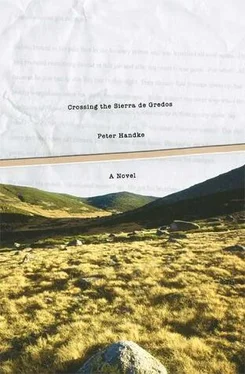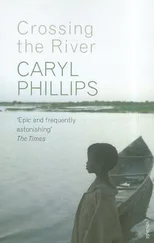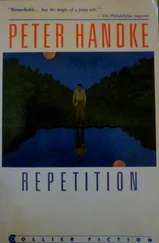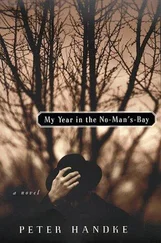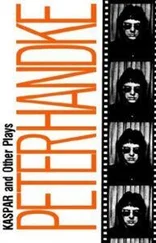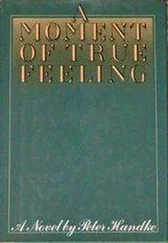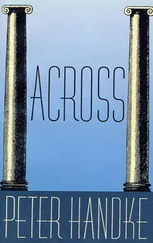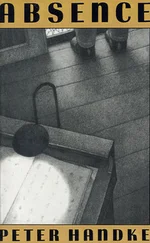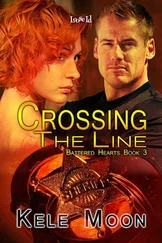Then a cry, of alarm? of joy?: someone was walking along the nocturnal road, ten paces ahead of him, and as he caught up with the figure in a single stride, she turned toward him, her face glowing in the pitch darkness, and he recognized, no, it struck him: a girl, no longer a child, but as young as a person can possibly be, a human being — his sister’s child. The cry — if it was a cry at all — had come neither from her nor from him.
“The history of the world is a mess,” he had written to his sister from prison one time, using no code for a change. “The race of man is an evil apparition and deserves to be wiped out.” In this nocturnal moment, however, he saw his own dictum as inoperative, and how. The face before him signified: he would not kill, not yet. A major act of violence was not for him, not yet. First he would sit down with his sister’s child, at the “Night-Travelers’ Lodge” up ahead.
As she did almost every night, she awoke after a couple of hours of deep sleep. She groped for the light switch, noticing only then that she was not sleeping in her own bed; that she was not at home. The initial discomfiture gave way to astonishment, and the astonishment energized her.
She sat up and fished the Arabic book from the citadel room’s uneven floor — fished: that was how high the bed was, and how far below the book. The child on the plane to Valladolid had spoken the truth: the book did not smell of her. It smelled of her vanished daughter. The girl had been reading it, lesson after lesson, example after example, quotation after quotation (the fragments of classical Arabic poetry with which every lesson ended). The book had been systematically studied and mined by her, word for word; traced; copied; glossed; threaded with marginal notes that eventually came to mean as much as, and then clearly more than, the print on the page, and referred only vaguely or not at all, or not obviously, to the text. The book — a mere brochure, actually — looked even from the outside as if it had been carded, kneaded, pulled lengthwise and widthwise and licked, as it were; rained on and snowed on.
And inside the covers things were even more exciting: the impression of an athletic contest continuing page after page, a wrestling match to the bitter end, which also had something joyful about it, not only because of the constantly changing pencil colors and the changing script, from Roman to Arabic, from Greek to shorthand.
And again from the outside, from the side, one could see where the reading had stopped, even before the book’s midpoint: the part that had been read or explored was gray — no, not “dirty gray”—, the pages curved, bent, thickened, crisscrossed, and sprinkled with little strokes or dots — traces of the marginal glosses inside, which often wanted to spill over the edges; then a white borderline, and after that nothing but the unread white layers; the gray next to this white like a different rock stratum; a different one? no, the same material in both layers of the brochure, with one layer simply transformed and corrugated by chemistry and warmth, the chemistry of sweat from the reading finger lingering for hours on a single pair of pages, the warmth of the writing hand.
And the mother took up the reading where her child had left off. She, however, never added anything to what she read. No underlining. She even opened the book carefully, her fingers moving as if she were wearing gloves. Reading the book from a distance, looking into it as into a remote niche. Anything not to leave traces. Nonetheless, a reading second to none: spelling out, with lips moving silently, bursting out with a word-sound here and there, and then again, and again, pausing, her eyes raised from the book as she mulled over the section she had just read, in its context, the more immediate and the wider one.
And this hour in the depths of the night seemed particularly favorable to her reading. These days one read to get away from the world even less than was perhaps usual; indeed, exactly the opposite was the case. Here stood the chair, with its woodworm holes. Over there the door latch curved downward. Over there was a ladder, leaning as only a ladder can — what an invention, the ladder! On the highway the milk truck loaded with filled milk cans, stacked one on top of the other, clicking as they jostled each other, and among the cans a refugee family, including the author as a child (here sneaking into her book and her story again — but for the last time, please!). Way off, on the farthest horizon, the train rattling by — already in motion for a long, long time, but audible only now as a result of her reading; in one compartment her lover, her missing life companion, without a ticket, without identification, suffering from a high fever, heading in a direction in which he did not want to go, the direction opposite from hers — but at least he was not dead, he was alive, he existed. And impaled on one thick thorn in the acacia avenue outside the window, a very small bird? a cicada? a dragonfly? — The door to the chamber where she lay reading was pushed open, and in streamed human body warmth.
No comfort in her reading-herself-out-into-the-world? Fortunately? Reading to find comfort was not real reading? Another pause at an Arabic word and then the word-sound bursting out: as if precisely these words demanded to be heard. And this explosive voicing of the sound provided additional illumination to the field of vision: each foreign word a sort of flashbulb that gave whatever was in the field of vision (and beyond it) contours, surging with life; as if with the ex-pression, the chair, the ladder, the latch, the thorn, were instantly created anew.
And the nocturnal reader soon fell asleep again, as if after a great expenditure of energy, and slept deeply, deeply. And after her reading she had an image of the bed on which she was lying as a map of the world. But the thorns now, longer and fatter than swords? They belong to an old wooden statue in the church of the Sorbian village, where they pierce, at all different angles, the bodies of martyrs — in the thigh, belly, thorax, neck. Perhaps her reading of Arabic was a mere backdrop. But sometimes this backdrop meant everything.
While she took a shower the next morning (a long, long one), got dressed (slowly, one article at a time), gazed out the open window on the south side (her eyes moving from her fingertips out over the entire plateau, which grew hilly again as it disappeared in the distance), more and more additional images zoomed into her, or merely brushed past her; no more images of martyrdom and menace. These new images were the kind of which she was convinced that one was sufficient to arm her — and not only her, but everyone (see her sense of mission) — for getting through even the most oppressive day.
And again she contemplated the conditions or laws that allowed such an image to seek a person out. The genesis, the origin, the source of these images must be explored at last; a necessity that made one all the freer; as, indeed, every time she said, “I must,” “one must,” a little smile seemed to float around her. At any rate, to be receptive to images one had to remain focused on the matter at hand, whatever it was (see showering, see gazing out the window). And no special slowing-down or even acceleration of the current activity was needed: whether one moved deliberately or rapidly — the decisive factor was to be fully engaged.
Likewise irrelevant were distance and proximity; only the proper interval yielded, or oscillated, the image, and a proper interval could be that of the thread to the needle, hardly a hand’s breadth from the eye: for instance, a bend in the Bidassoa, the river marking the border to the Basque country, appeared — image, a jolt into the world, a jolt, all the more necessary for everyone, into reality.
Читать дальше
